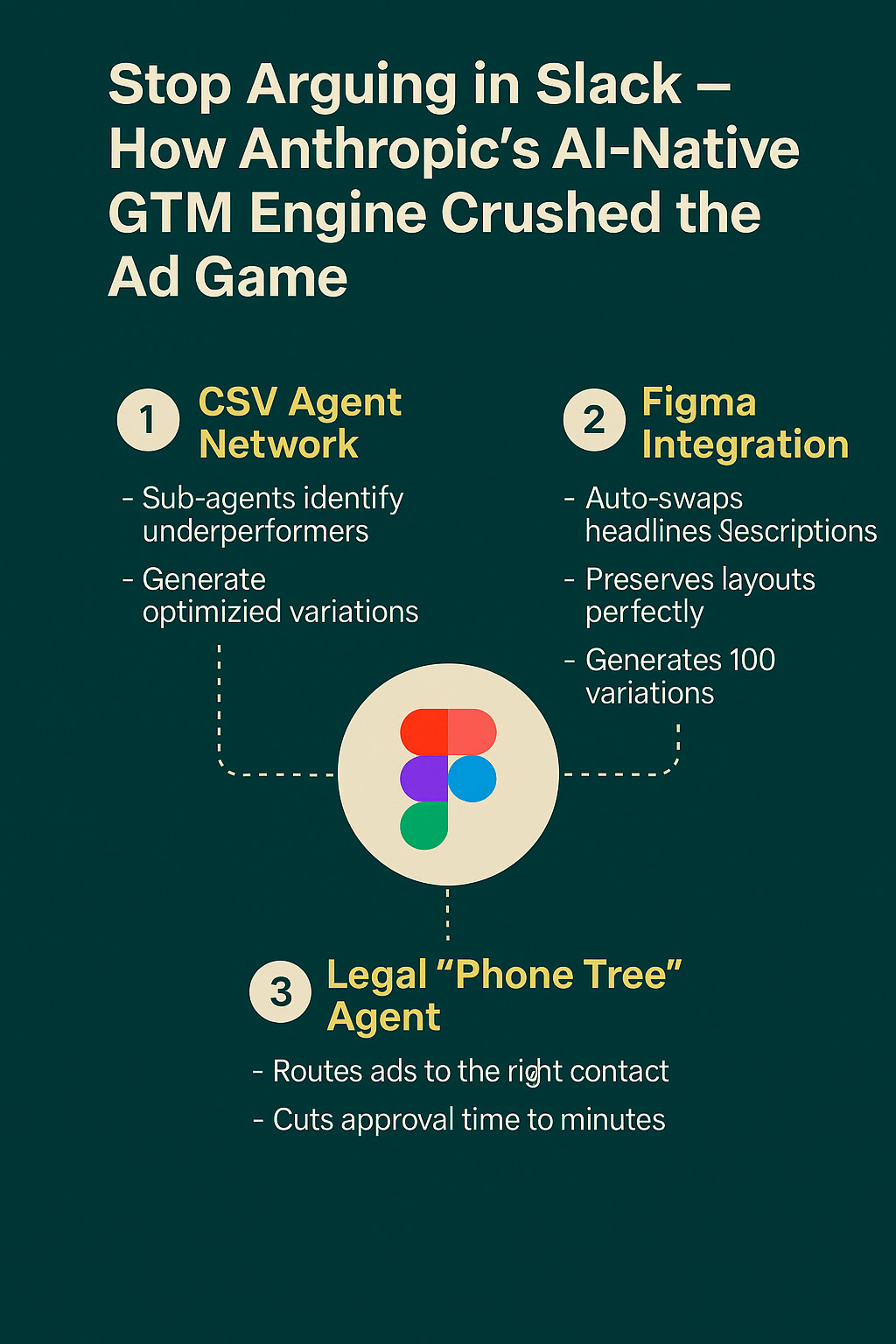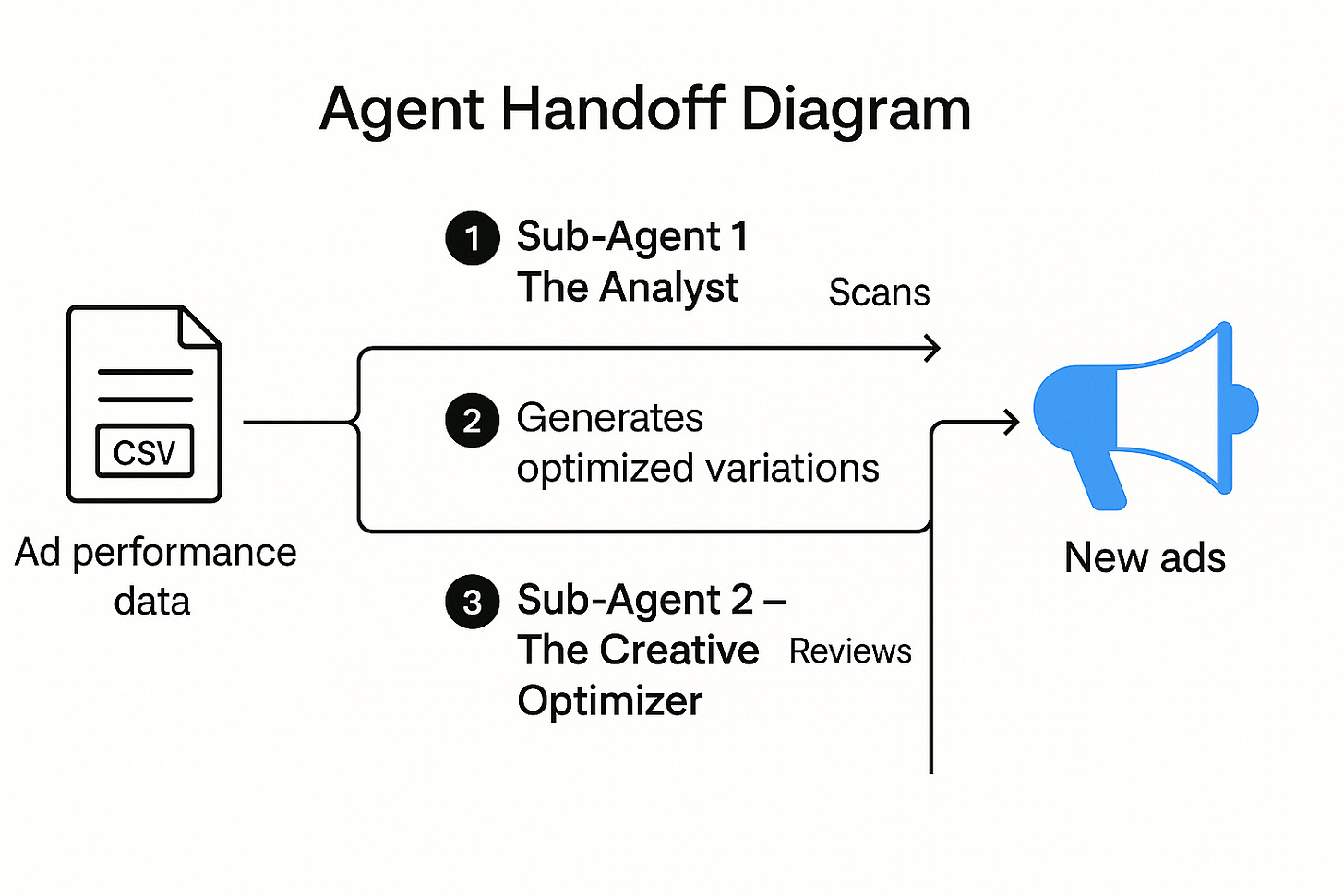How Anthropic’s AI-Native GTM Engine Crushed the Ad Game
Teardown their playbook to re-write your GTM with extraordinary automation, agility and execution
The AI-Native GTM Team Is Here
Last week, I watched Anthropic’s GTM team generate 100 high-performing ad variations in seconds — the kind of output that normally takes an enterprise GTM team days or weeks
Meanwhile, most teams were still:
→ Debating ad copy in Slack
→ Waiting for agency turnarounds
→ Copy-pasting into Figma like it’s 2018
Anthropic? They’ve gone full AI-native orchestration — not “a bot that writes copy,” but a mesh of AI agents running like a miniature internal SaaS platform, purpose-built for GTM.
1. The CSV Agent Network
Here’s the difference between a “prompt” and an agent network: prompts are one-off instructions. An agent network is a coordinated set of autonomous processes, each with its own job, inputs, and outputs, passing work to the next link in the chain.
Sub-Agent 1 – The Analyst
Watches a shared performance folder for new CSV drops from the ad platform.
Parses CTR, CVR, ROAS metrics, flags underperformers against historical benchmarks.
Scores creative variants so “winners” and “losers” are automatically classified.
Sub-Agent 2 – The Creative Optimiser
Pulls the flagged under-performers.
Rewrites headlines/descriptions within strict guardrails: brand tone, character limits, keyword density.
Uses style embeddings so the tone stays consistent even when it’s rewritten 100 different ways.
Sub-Agent 3 – The QA Gatekeeper
Runs the new ads against banned-words lists, compliance rules, and accessibility checks (contrast, readability).
Kicks anything that fails back into the loop for regeneration.
Result: continuous improvement without endless review cycles. Humans step in only to approve or deploy.
2. Figma Integration – The Bottleneck Killer
This is where “ideas” turn into velocity.
Most AI-generated copy still dies in Google Docs or Notion because designers have to manually format it. Anthropic’s agents write, style, and insert directly into Figma’s component system:
Auto-swaps copy into pre-defined headline and description fields.
Preserves layout constraints pixel-perfect.
Generates 100 ad variations in ~0.5 seconds with zero reformatting.
When you cut the “hand it to design” lag, you kill the slowest link in most GTM chains.
3. Legal ‘Phone Tree’ Agent – Compliance at Speed
Legal has historically been the final boss that kills campaign momentum. Anthropic solved this by making compliance parallel, not sequential.
Ads are routed by AI to the correct legal owner instantly (based on campaign type, region, product line).
Summaries are pre-written so legal sees only what’s changed and why.
Auto-logging ensures every approval is auditable for regulators.
Approval time dropped from days to minutes — and legal became a speed multiplier.
Why This Works
Claude now leads enterprise AI adoption (32% vs 25% for OpenAI), and this is why:
They’re not trying to “find the perfect prompt.” They’re deleting whole categories of human delay:
No analyst lag for performance insights.
No tool-switching friction.
No compliance bottlenecks.
The AI-Native GTM Workflow Blueprint
If you want Anthropic’s speed, here’s how to design it:
Map Bottlenecks → Identify the hand-offs, wait times, and repetitive tasks your GTM team hates most.
Assign Specialist Agents → Don’t build one big “do everything” bot; build a role-based stack: Analysis, Generation, QA, Routing.
Integrate Natively → Skip the “copy to doc” phase. Feed outputs straight into Figma, CRM, CMS, or ad managers.
Automate Compliance Early → Run brand and legal checks in-flight, not at the end.
Close the Loop → Performance drops should trigger regeneration — no human ticket required.
The Next GTM Edge
The next GTM advantage won’t come from having GPT-5 or Claude 4.
It will come from re-architecting your workflows so manual steps disappear and creative output compounds.
The question isn’t “What can AI generate?” anymore.
It’s: “How much of your workflow can you delete?”
Bonus: What Else These Agents Could Do
This framework doesn’t just apply to ads. You can spin the same model into:
Content Repurposing Agent Chains → Turn webinars into social clips, blog posts, and SEO pages without a single copy-paste.
Lead Qualification Agents → Pull CRM leads, enrich them with firmographics, and score them in real time.
Customer Onboarding Agents → Auto-generate personalised onboarding flows from a template library based on customer profile.
Market Intel Agents → Scrape competitor ads, classify them by strategy, and simulate variants in your own brand voice.
In other words: the GTM agent stack isn’t a tool. It’s an operating system.
The AI-Native GTM Workflow Playbook
Want to replicate Anthropic’s speed? Here’s the high-level blueprint:
Map Your Bottlenecks
→ Find the hand-offs, wait times, and repetitive tasks your GTM team hates most.Assign Agent Roles
→ Instead of one “do everything” bot, build specialist agents for analysis, generation, QA, and routing.Integrate Directly Into Tools
→ Don’t settle for “output to doc.” Feed directly into Figma, CRM, CMS, or ad managers.Automate Compliance Early
→ Bake legal/brand checks into the flow so nothing stalls downstream.Monitor in Real Time
→ Build feedback loops that trigger automatic iterations when performance drops.
The next GTM advantage won’t come from having GPT-5 or Claude 4.
It’ll come from re-architecting your entire workflow so manual steps disappear and creative output compounds.
The question isn’t “what can AI generate?” anymore.
It’s: how much of your workflow can you delete?





Really feels like we’re entering a phase where the question isn’t what AI can make, but how much work it can delete. That line stuck with me.
Thanks